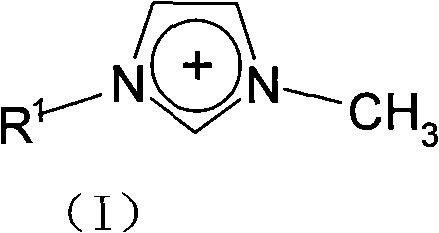Method for preparing ionic liquid containing cellulose triacetate through adopting bagasse cellulose as raw material
A technology of cellulose triacetate and ionic liquid is applied in the field of preparation of cellulose triacetate, which can solve the problems of demand and large cellulose acetate, and achieve the effects of saving energy consumption, uniform product properties and simple process
- Summary
- Abstract
- Description
- Claims
- Application Information
AI Technical Summary
Problems solved by technology
Method used
Image
Examples
Embodiment 1
[0025] Weigh about 0.6g of bagasse cellulose and 14.4g of ionic liquid 1-allyl-3-methylimidazolium chloride (AMIMCl) into a round bottom flask, heat to 80°C in an oil bath, seal and vigorously stir mechanically for 4h. A clear and transparent cellulose solution was obtained, and the concentration of the cellulose solution was 4% (mass fraction). At the same time, acetic anhydride (about 0.735 ml) was added to the solution, so that the molar ratio of acetic anhydride to cellulose glucose unit was 10:1, the reaction temperature of acetylation was 100°C, and the reaction was carried out for 8 hours. After the reaction was completed, an aqueous solution 3 times the volume of the ionic liquid was added, and the product was repeatedly washed with water, then placed in a vacuum drying oven, and dried at 60°C for 24 hours; at the same time, the water in the washing liquid was removed by rotary evaporation to realize the recovery of the ionic liquid. After testing, the obtained cellulo...
Embodiment 2
[0027] Weigh about 0.6g of bagasse cellulose and 14.4g of ionic liquid 1-allyl-3-methylimidazolium chloride (AMIMCl), put them into a round bottom flask, heat to 80°C in an oil bath, seal and stir vigorously for 4h . A clear and transparent cellulose solution was obtained, and the concentration of the cellulose solution was 4% (mass fraction). Acetyl chloride (about 1.58ml) was added to the solution, so that the molar ratio of acetic anhydride to cellulose glucose unit was 8:1, the reaction temperature of acetylation was 100°C, and the reaction was carried out for 8 hours. The post-treatment of the reaction mixture and the recovery of the ionic liquid are basically the same as in Example 1, except that water 4 times the volume of the ionic liquid is added to the reaction mixture. After testing, the acetyl substitution degree of the product obtained is DS=2.98 .
Embodiment 3
[0029]Weigh about 0.6g of bagasse cellulose and 11.4g of ionic liquid 1-butyl-3-methylimidazolium chloride (BMIMCl) into a round bottom flask, heat to 90°C in an oil bath, seal and vigorously stir mechanically for 6h. A clear and transparent cellulose solution was obtained, and the concentration of the cellulose solution was 5% (mass fraction). Acetic anhydride (about 2.45ml) was added to the solution, so that the molar ratio of acetic anhydride to cellulose glucose unit was 10:1, the reaction temperature of acetylation was 120°C, and the reaction was carried out for 7 hours. The post-treatment of the reaction mixture and the recovery of the ionic liquid are basically the same as in Example 1, except that water 5 times the volume of the ionic liquid is added to the reaction mixture. After testing, the acetyl substitution degree of the product obtained is DS=2.99 .
PUM
 Login to View More
Login to View More Abstract
Description
Claims
Application Information
 Login to View More
Login to View More - R&D
- Intellectual Property
- Life Sciences
- Materials
- Tech Scout
- Unparalleled Data Quality
- Higher Quality Content
- 60% Fewer Hallucinations
Browse by: Latest US Patents, China's latest patents, Technical Efficacy Thesaurus, Application Domain, Technology Topic, Popular Technical Reports.
© 2025 PatSnap. All rights reserved.Legal|Privacy policy|Modern Slavery Act Transparency Statement|Sitemap|About US| Contact US: help@patsnap.com


